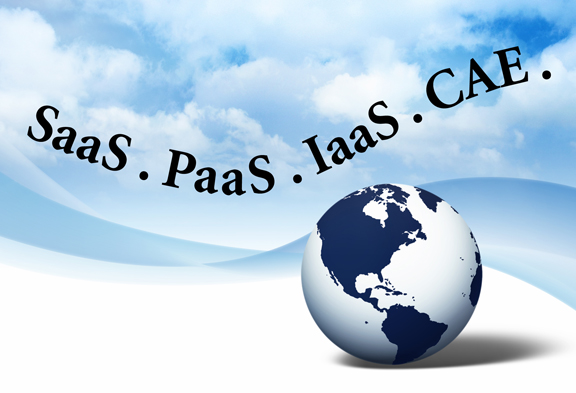January 7, 2014
Whether you’re pro-cloud or anti-cloud, you’d be hard pressed to ignore the commotion caused by the cloud in 2013. To me, the emergence of start-ups like Rescale, CyDesign, and CieSpace signaled the beginning of a new era. Their products give the industry a serious reason to redefine the familiar acronym CAE as Cloud-Aided Engineering instead of Computer-Aided Engineering.
Large manufacturers have been using the private cloud—on-premise high-performance computing (HPC) servers—for years, so that’s not news. But these new vendors are breaking from that tradition by advancing the use of the public cloud: computing resources managed and maintained by the vendor, offered on some type of pay-per-use licensing. Since they deliver not only software products but also on-demand computing power, the old term SaaS (Software as a Service) proves inadequate. The new offerings are often described as IaaS (Infrastructure as a Service) or PaaS (Platform as a Service).
Dennis Nagy, founder and principal of BeyondCAE, observed, “Easy, affordable, incremental, by-the-drink remote access to powerful compute cycles has a lot of appeal, both financially and technically, but corporate security concerns are still the counter-force at this point.”
Prasad Mandava, cofounder and CEO of Visual Collaboration Technologies, cautioned “many cultural hurdles/concerns/barriers” stand in the way of widespread adoption of such solutions.”
On-premise HPC is still the preferred setup for large enterprises and those who deal with extremely sensitive IP (for example, government and military contractors), but for small and midsize manufacturers dabbling in simulation, the ability to pay for software and hardware per usage without the burden of ownership makes IaaS and PaaS much more attractive. Many may consider the security risk associated with the public cloud an acceptable tradeoff for the cost savings offered by IaaS and PaaS.
The rise of cloud solutions is made possible, I believe, by the technology consumers’ shifting preference from ownership to on-demand access. The classic design and engineering software licensing model (significant upfront cost, followed by annual maintenance) works well for established companies with stable supply chains and predictable commerce. But in the fast-paced start-up age, many smaller design and engineering firms may prefer the pay-as-you-go licensing model.
The smaller, incremental monthly costs of SaaS—even if it adds up to be much higher than the cost of a perpetual license over time—is just more manageable for these companies. It allows them to experiment with different types of software while they struggle to define their product or find an audience. The new attitude has prompted traditional software giants like Autodesk and Siemens PLM to begin introducing monthly subscriptions. (More on this here and here.)
Both the cloud and the new licensing schemes may be harbingers to a new kind of CAE software: modular, designed for repeatable specific tasks, accessible from different devices running different operating systems, targeted at non-experts—essentially, an imitation of the Apple app store.
The term “expert” and “non-expert,” however, are up for debate. Nagy said, “I continue to use [‘expert’] to cover people who spend most of their work time knowing and using the simulation tools available ... [A ‘non-expert’] is well-grounded engineer [who] knows something about the physics of stress, vibration, flow, but is not an expert in the simulation methods or any particular CAE software tools.”
Joe Walsh, founder and CEO of intrinSIM LLC, observed, “Significant use of simulation by non-experts needs a significant change in the required expertise. That’s the opportunity at hand (challenge for pessimists).”
The introduction of simple SaaS apps—for example, a drop test simulator or a wind tunnel simulator accessible from a browser—could broaden the reach of SaaS-style simulation even further. If developed with a highly intuitive user interface, they could bring FEA and CFD well within reach of designers who seldom use simulation (or have never used it in the past).
Autodesk currently offers Project Falcon, a free technology preview for simulating wind tunnel results. With a simple setup and minimum input entries, the program is ideal for non-experts. Altair also offers a HyperWorks Virtual Wind Tunnel, built on an automated and streamlined workflow. Still, the expertise required to run Altair’s product may be more than what’s expected with Autodesk’s Project Falcon. (Hence, the debatable definition of “non-expert.”) Neither of them are cloud-hosted SaaS products. Autodesk also offers a wizard-based drop-test simulator, but it’s an add-on for Autodesk Inventor, not a SaaS offering.
Derek Cooper, director of Autodesk’s digital simulation product line, said, “I think one of the most significant big changes [in 2013] in CAE is the true introduction of the cloud. It’s far from sorted out, business models will change, and tech will change and evolve.”
Traditional software merchants who specialize in high-end CAE products may not yet consider the emerging SaaS products a significant threat. The cloud’s privacy and security concerns (some are legitimate, others merely cultural) and current manufacturing titans’ established workflows built on in-house data centers offer them assurance.
But sooner or later, prompted by hard times or the need to tighten the belt, some of the biggest automotive and aerospace manufacturers will start adopting SaaS offerings. That, I think, is inevitable, and the time to prepare for that inevitability with R&D is now.
This post was largely based on a discussion (still ongoing) at the LinkedIn group New Trends in CAE Simulation.
Subscribe to our FREE magazine, FREE email newsletters or both!
About the Author
Kenneth Wong is Digital Engineering’s resident blogger and senior editor. Email him at [email protected] or share your thoughts on this article at digitaleng.news/facebook.
Follow DE






